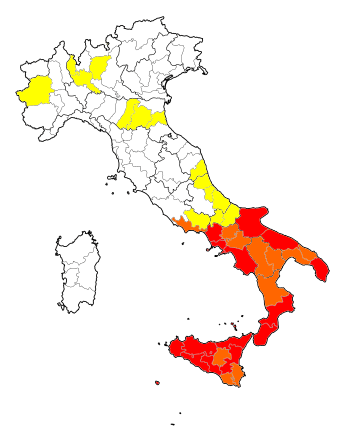Pizzo (extortion)

The pizzo is protection money paid to the Mafia often in the form of a forced transfer of money, resulting in extortion. The term is derived from the Sicilian pizzu ('beak'). To let someone wet their beak (Sicilian language "fari vagnari u pizzu") is to pay protection money. The practice is widespread in Southern Italy, not only by the Sicilian Cosa Nostra, but also by the 'Ndrangheta in Calabria and the Camorra in Campania.
Another etymological explanation of the term is "beakerful", referring to the right of an overseer to scoop from the grain being threshed by peasants.[1] Paying the pizzo might also be in kind, for example by forcing a company to put someone (often a member of a criminal organisation) on the payroll, compulsory provision of services by Mafia controlled businesses as well as subcontracting to Mafia controlled companies.[2]
Businesses that refuse to pay the pizzo might be burned down. In return, businesses receive "protection" and can enlist neighbourhood Mafiosi to cut through bureaucracy or resolve disputes with other tradesmen. Collecting the pizzo keeps the Mafia in touch with the community and allows it to "control their territory".[3]
The Mafia extorts more than 160 million euro a year from shops and businesses in the Palermo region, with the island as a whole paying 10 times that figure, investigators estimate.[4] Around 80 per cent of Sicilian businesses pay up a pizzo.[5] According to Palermo University, the pizzo averages 457 euros (640 dollars) a month for retail traders and 578 for hotels and restaurants, but construction companies are asked to pay over 2,000 euros per month according to economic daily Il Sole 24 Ore's figures.[6]
One of the first to refuse to pay protection money was Libero Grassi, a shopkeeper from Palermo. In January 1991, he wrote an open letter to the Giornale di Sicilia, the local newspaper. Published on the front page, it was addressed to an anonymous "Dear Extortionist". It caused an uproar and, later that same year, Grassi was dead.[7]
In 2004, Addiopizzo – a grassroots social conscious-motivated consumer movement – frustrated with the Mafia's stranglehold on the local economy and political life, peppered Palermo with stickers stating: "A people who pays the pizzo is a people without dignity." They organise demonstrations wearing black T-shirts with the Addiopizzo logo, a broken circle with an X in the middle and the words "consumo critico" (critical consumption).[8]
References
- ↑ Paoli, Mafia Brotherhoods, p. 241
- ↑ Paoli, Mafia Brotherhoods, p. 164
- ↑ The pizzo racket, The Daily Telegraph, April 28, 2006
- ↑ Mafia-free supermarket defies mob extortion, The Daily Telegraph, March 8, 2008
- ↑ Italy's biggest business: the Mafia, The Daily Telegraph, October 24, 2007
- ↑ To the Mafia's horror, pizzo-free shop opens Palermo doors, AFP, March 8, 2008
- ↑ Sicilians grow defiant of Mafia, BBC News, April 11, 2008
- ↑ One Hundred Defiant Shopkeepers Say "We Don’t Pay Protection Money", Corriere della Sera, May 5, 2006
- Paoli, Letizia (2003). Mafia Brotherhoods: Organized Crime, Italian Style, New York: Oxford University Press ISBN 0-19-515724-9 (Review by Klaus Von Lampe) (Review by Alexandra V. Orlova)